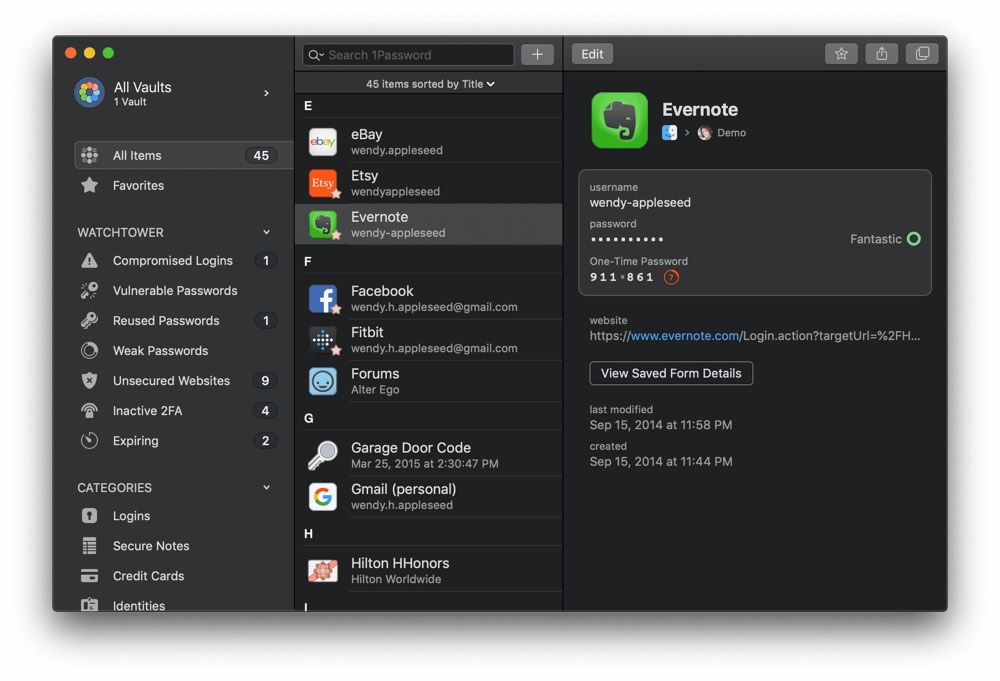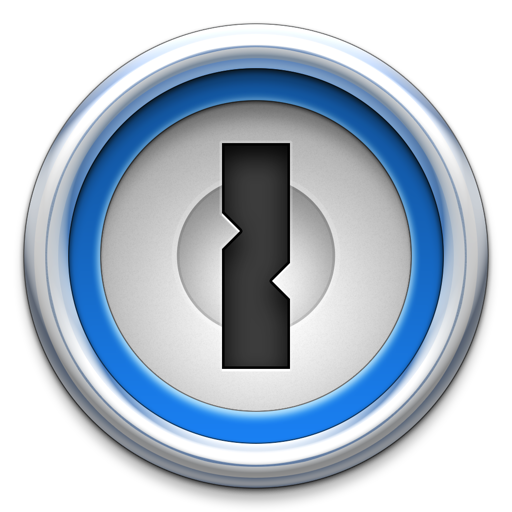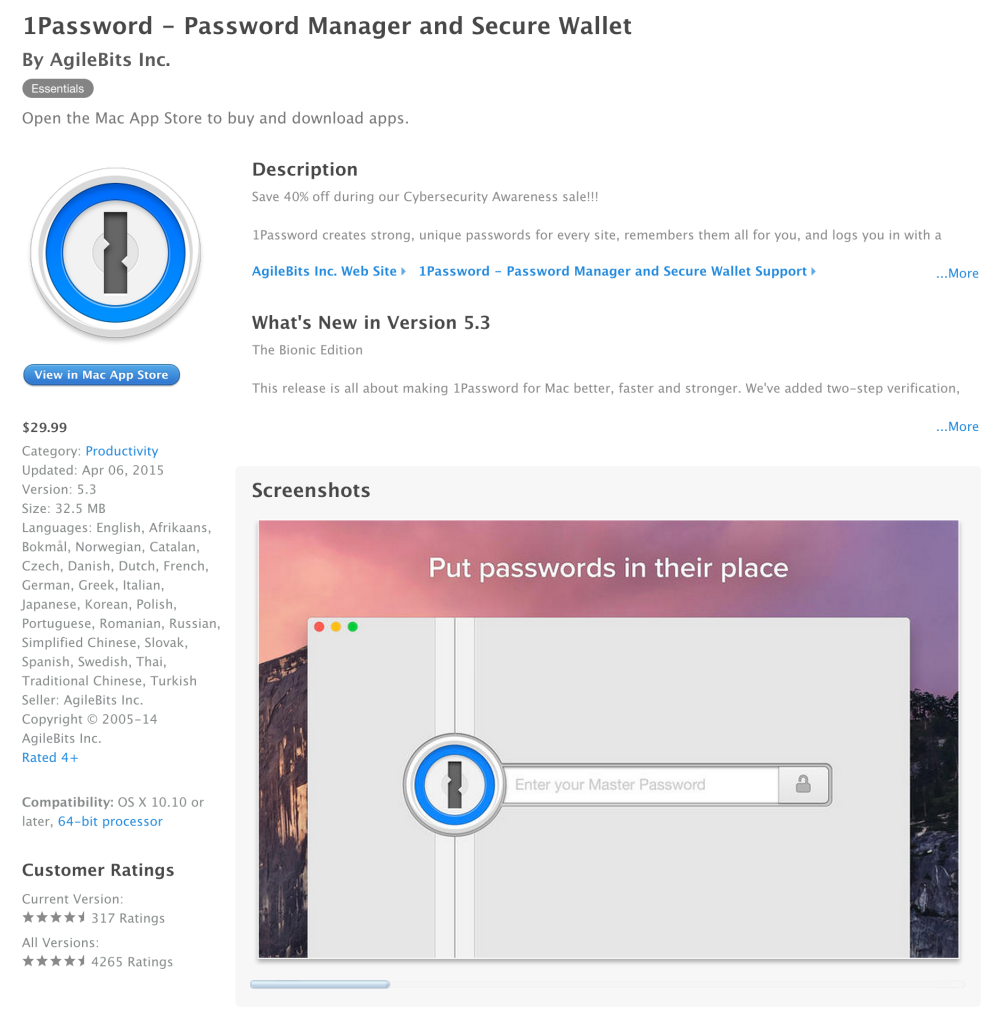
- 1password Security
- Lastpass Vs 1password Security
- 1password Security Whitepaper
- How Safe Is One Password
1Password is periodically assessed to make sure it remains a secure way for you to share all your secrets.
Cure53
Cure53 was engaged to perform a pentest on the web based components of 1Password. The assessment was performed in October 2020.
Disclaimer: I work for AgileBits, makers of 1Password. Thanks for asking me to answer this, Marc Bodnick. The short answer is that your data is safe in 1Password. Fundamental design choices were made to protect everything you store in 1Password.
Full details are available in the Cure53 report
1Password is SOC 2 type 2 certified. SOC, or Service Organization Control, is an independent auditing process that makes sure that 1Password securely manages data to protect customers' interests and privacy. To request a copy of the SOC 2 report, contact the 1Password Business team. Learn more about SOC 2 certification of 1Password. Security and privacy About your Secret Key Your Secret Key keeps your 1Password account safe by adding another level of security on top of your Master Password. Your Secret Key is 34 letters and numbers, separated by dashes. 1Password includes a security audit feature that's really worth checking out after you've got the bulk of your passwords entered in. The audit can check for duplicate passwords, weak passwords.
SOC
1Password is SOC 2 type 2 certified. SOC, or Service Organization Control, is an independent auditing process that makes sure that 1Password securely manages data to protect customers' interests and privacy. To request a copy of the SOC 2 report, contact the 1Password Business team.
Learn more about SOC 2 certification of 1Password.
Bugcrowd

Bugcrowd, Inc. is engaged in an ongoing, private bug bounty program targeting the 1Password service and web-application. Testers are provided with details of the API.
This program is currently open to the public and has received submissions from 387 unique researchers. These issues ranged in scope and severity, with nine high priority issues being discovered during this time frame. Despite the presence of these high priority findings no user secrets were at risk. Additionally, as of January 1, 2020, all the high priority submissions from this program were confirmed to be resolved.
None of the identified issues resulted in a loss of confidentiality, integrity, or availability.
Full details are available in the Bugcrowd security review
ISE
Independent Security Evaluators (ISE) was engaged to perform a penetration test and code review of the 1Password system. The assessment was performed during April and June, 2020.
Full details are available in the ISE security assessment report
Onica
Onica was engaged to perform an assessment and audit of existing 1Password security architecture, infrastructure configurations, tools, and practices.
The review of the current AWS environments showed evidence that the AgileBits teams have undertaken significant research and gained a solid understanding of best practices from a platform level. The fundamentals of security best practices are being executed in the implementation.
Full details are available in the Onica security audit report
AppSec

AppSec Consulting was contracted to perform a penetration test and code review of the 1Password application. The assessment was performed during July, 2018.
The security controls observed in the 1Password application were found to be substantial and unusually impressive.
Full details are available in the AppSec security review
nVisium
nVisium LLC was employed to perform a security assessment of the 1Password infrastructure. The assessment was performed during October and November, 2015.
It is nVisium's estimation that the current overall risk to AgileBits through the Cloud Infrastructure is low.
Full details are available in the nVisium security review
CloudNative
CloudNative, Inc. was employed to analyze 1Password and provide best-practices guidance. The assessment was performed during September and October, 2015, prior to the public beta period.
Full details are available in the CloudNative security review
Learn more
Learn how to set up a security key, like YubiKey or Titan, so you can use it for two-factor authentication in 1Password.Tip
If you don't have a U2F security key, use two-factor authentication with an authenticator app.
Set up your security key
Before you can use your security key as a second factor for your 1Password account, you'll need to turn on two-factor authentication for your 1Password account. Then follow these steps:
- Sign in to your account on 1Password.com on your computer.
- Click your name in the top right and choose My Profile.
- Click More Actions > Manage Two-Factor Authentication.
- Click Add a Security Key.
If you don't see Add a Security Key, turn on two-factor authentication for your 1Password account.
- Enter a name for your security key and click Next.
- Insert your security key into the USB port on your computer.
If Windows Security asks you to create a PIN, enter one and click OK. Your PIN is stored locally on your security key.
- Touch the sensor on your security key.
- When you see 'Your security key was successfully registered', click Done.
From now on, you can use your security key instead of a six-digit authentication code to sign in to your 1Password account in your browser, 1Password for iOS, and 1Password for Android. Ps4 remote play steam controller.
View and manage your security keys
To view your security keys:
- Sign in to your account on 1Password.com.
- Click your name in the top right and choose My Profile.
- Click More Actions > Manage Two-Factor Authentication.
To prevent a security key from being used as a second factor, click Remove next to it.
To allow another security key to be used as a second factor, click Add a Security Key and follow the onscreen instructions.
Learn how to view and manage computers and mobile devices that are authorized to use your 1Password account.
Get help
You can use your security key as a second factor for your 1Password account:
- on 1Password.com
- on your iPhone or iPad (requires YubiKey 5 NFC, YubiKey 5C NFC, or YubiKey 5Ci)
- on your Android device
Using your security key as a second factor requires:
- a 1Password membership with two-factor authentication turned on
- a U2F security key, like YubiKey or Titan
To sign in to your account in the 1Password apps or in a browser without U2F support, enter a six-digit authentication code from your authenticator app.
If you lose access to your security key
If you lose access to your security key, you can still sign in to your 1Password account:

- 1password Security
- Lastpass Vs 1password Security
- 1password Security Whitepaper
- How Safe Is One Password
1Password is periodically assessed to make sure it remains a secure way for you to share all your secrets.
Cure53
Cure53 was engaged to perform a pentest on the web based components of 1Password. The assessment was performed in October 2020.
Disclaimer: I work for AgileBits, makers of 1Password. Thanks for asking me to answer this, Marc Bodnick. The short answer is that your data is safe in 1Password. Fundamental design choices were made to protect everything you store in 1Password.
Full details are available in the Cure53 report
1Password is SOC 2 type 2 certified. SOC, or Service Organization Control, is an independent auditing process that makes sure that 1Password securely manages data to protect customers' interests and privacy. To request a copy of the SOC 2 report, contact the 1Password Business team. Learn more about SOC 2 certification of 1Password. Security and privacy About your Secret Key Your Secret Key keeps your 1Password account safe by adding another level of security on top of your Master Password. Your Secret Key is 34 letters and numbers, separated by dashes. 1Password includes a security audit feature that's really worth checking out after you've got the bulk of your passwords entered in. The audit can check for duplicate passwords, weak passwords.
SOC
1Password is SOC 2 type 2 certified. SOC, or Service Organization Control, is an independent auditing process that makes sure that 1Password securely manages data to protect customers' interests and privacy. To request a copy of the SOC 2 report, contact the 1Password Business team.
Learn more about SOC 2 certification of 1Password.
Bugcrowd
Bugcrowd, Inc. is engaged in an ongoing, private bug bounty program targeting the 1Password service and web-application. Testers are provided with details of the API.
This program is currently open to the public and has received submissions from 387 unique researchers. These issues ranged in scope and severity, with nine high priority issues being discovered during this time frame. Despite the presence of these high priority findings no user secrets were at risk. Additionally, as of January 1, 2020, all the high priority submissions from this program were confirmed to be resolved.
None of the identified issues resulted in a loss of confidentiality, integrity, or availability.
Full details are available in the Bugcrowd security review
ISE
Independent Security Evaluators (ISE) was engaged to perform a penetration test and code review of the 1Password system. The assessment was performed during April and June, 2020.
Full details are available in the ISE security assessment report
Onica
Onica was engaged to perform an assessment and audit of existing 1Password security architecture, infrastructure configurations, tools, and practices.
The review of the current AWS environments showed evidence that the AgileBits teams have undertaken significant research and gained a solid understanding of best practices from a platform level. The fundamentals of security best practices are being executed in the implementation.
Full details are available in the Onica security audit report
AppSec
AppSec Consulting was contracted to perform a penetration test and code review of the 1Password application. The assessment was performed during July, 2018.
The security controls observed in the 1Password application were found to be substantial and unusually impressive.
Full details are available in the AppSec security review
nVisium
nVisium LLC was employed to perform a security assessment of the 1Password infrastructure. The assessment was performed during October and November, 2015.
It is nVisium's estimation that the current overall risk to AgileBits through the Cloud Infrastructure is low.
Full details are available in the nVisium security review
CloudNative
CloudNative, Inc. was employed to analyze 1Password and provide best-practices guidance. The assessment was performed during September and October, 2015, prior to the public beta period.
Full details are available in the CloudNative security review
Learn more
Learn how to set up a security key, like YubiKey or Titan, so you can use it for two-factor authentication in 1Password.Tip
If you don't have a U2F security key, use two-factor authentication with an authenticator app.
Set up your security key
Before you can use your security key as a second factor for your 1Password account, you'll need to turn on two-factor authentication for your 1Password account. Then follow these steps:
- Sign in to your account on 1Password.com on your computer.
- Click your name in the top right and choose My Profile.
- Click More Actions > Manage Two-Factor Authentication.
- Click Add a Security Key.
If you don't see Add a Security Key, turn on two-factor authentication for your 1Password account.
- Enter a name for your security key and click Next.
- Insert your security key into the USB port on your computer.
If Windows Security asks you to create a PIN, enter one and click OK. Your PIN is stored locally on your security key.
- Touch the sensor on your security key.
- When you see 'Your security key was successfully registered', click Done.
From now on, you can use your security key instead of a six-digit authentication code to sign in to your 1Password account in your browser, 1Password for iOS, and 1Password for Android. Ps4 remote play steam controller.
View and manage your security keys
To view your security keys:
- Sign in to your account on 1Password.com.
- Click your name in the top right and choose My Profile.
- Click More Actions > Manage Two-Factor Authentication.
To prevent a security key from being used as a second factor, click Remove next to it.
To allow another security key to be used as a second factor, click Add a Security Key and follow the onscreen instructions.
Learn how to view and manage computers and mobile devices that are authorized to use your 1Password account.
Get help
You can use your security key as a second factor for your 1Password account:
- on 1Password.com
- on your iPhone or iPad (requires YubiKey 5 NFC, YubiKey 5C NFC, or YubiKey 5Ci)
- on your Android device
Using your security key as a second factor requires:
- a 1Password membership with two-factor authentication turned on
- a U2F security key, like YubiKey or Titan
To sign in to your account in the 1Password apps or in a browser without U2F support, enter a six-digit authentication code from your authenticator app.
If you lose access to your security key
If you lose access to your security key, you can still sign in to your 1Password account:
On 1Password.com
When you're asked for your security key, click Cancel. Then click 'Use your authenticator app instead' and enter a six-digit authentication code from your authenticator app.
On your iPhone or iPad
1password Security
When you see Two-Factor Authentication Required, choose Authentication Code, then enter a six-digit authentication code from your authenticator app.
Lastpass Vs 1password Security
On your Android device
1password Security Whitepaper
When you see 'Use your security key with 1Password', tap the back button on your device and enter a six-digit authentication code from your authenticator app.
How Safe Is One Password
Get help if you also lost access to your authenticator app.

